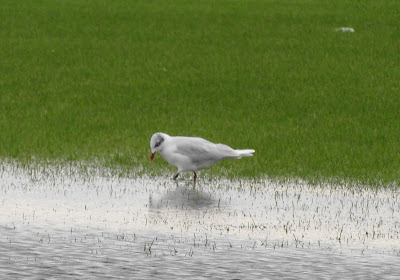Mild, wet and windy - There hasn`t been much change to the local birding scene around New Romney this past week or so, apart from a Mistle Thrush that has started singing in the town park every morning, despite the strong wind, and playing up its country name of Storm Cock. Our Ted walks have mainly taken us across the arable tracts around town and down to the Salts where farmland birds have been few and far between. The rough fields near Lade north have been the most productive for the likes of Meadow Pipit, Skylark, Redwing and Fieldfare and where several Snipes have been noted, plus a ringtail Hen Harrier yesterday. Visits to Dungeness and Walland Marsh have produced the usual wintering seabirds at the former site and small numbers of Bewick`s and Whooper Swans from the Midley wall at the latter. A wind-swept Lade has been quiet apart from up to six Goldeneyes, while 50 Knots were noted on the beach from the Tavern viewpoint his morning.
Highlights of the Birding Year
It`s that time of year when we cast a look over our shoulder at the avian events of 2023 across the Marsh. No two years are ever the same, such is the ebb and flow of birds, both migrant and resident species, when linked to our unpredictable weather, rapidly warming climate and changing land use.
Bewick`s Swans, Walland MarshHowever, the first winter period was fairly predictable with decreasing numbers of Bewick`s Swans and White-fronted Geese wintering on the arable lands across Walland Marsh, in contrast to thousands of Starlings, Lapwings and Golden Plovers; while there was also a surge in Cattle Egret and Glossy Ibis sightings across the Dungeness wetlands and throughout the year. Several Dartford Warblers haunted gorse thickets on the peninsula and one or two Short-eared Owls and Hen Harriers wintered. For the first time in living memory there was a notable absence of Smew (formerly a regular visiting sawbill from northern Europe) amongst the wintering wildfowl.
Glossy Ibis, Cook`s PoolThe Dungeness area has an enviable track record of overshooting spring rarities from the south and this year was no exception. A diminutive Short-toed Treecreeper somehow crossed the Channel and was discovered in a private garden on the estate, while transient Serin, Alpine Swift and Bee-eater sightings showed to the delight of a handful of observers. On the RSPB reserve Black-winged Stilts are now a given in spring, as is the more secretive, reed-bed loving Purple Heron, while a Penduline Tit was the first for several years. A Red-footed Falcon from the east was also noted for a few days hunting dragonflies over the desert, in contrast to an all too brief Caspian Tern on the ARC lake.
Several pairs of Marsh Harriers bred locally this year, along with Bittern and Bearded Tit, plus Peregrine, Raven, Wheatear and Black Redstart on and around the power station complex. Avocets attempted to nest at Scotney gravel pits, while it was another blank year for Common Terns on Burrowes. Across the Marsh farmland the `purring` song of the Turtle Dove could still be heard at a handful of locations and the downward spiral of Tree Sparrows continues to show cause for concern.
Black Redstart, Dungeness`Autumn` migration commenced in late June with the first returning Sand Martins and Green Sandpipers and picked up through mid-summer with good numbers of Willow Warblers and the shorebird passage at Dungeness RSPB and Lade Bay. Wood Sandpipers and Little Ringed Plovers were particularly well represented this year amongst a host of common shanks and sandpipers and a one-day Marsh Sandpiper, a vagrant from the Russian steppes. However, passerine diversity on the land was yet again poor with a distinct lack of so-called `sub-rarities` such as shrikes. Seabirds migrating off Dungeness saved the autumn blues and included several scarce Sabine`s Gulls, Long-tailed Skuas and Grey Phalaropes, plenty of Balearic Shearwaters and a memorable passage of Storm and Leach`s Petrels and Sooty Shearwaters courtesy of Storm Ciaran.
My candidate for bird of the year though went to a superb juvenile Pallid Harrier in October that frequented the farmland around Dungeness and Lydd, and even remained for a couple of weeks so that many local and visiting birders could enjoy this eastern raptor, and a first area record. The list of autumn rarities continued apace with a Black Stork over Lydd, another Short-toed Treecreeper at Dungeness and a Dusky Warbler on the bird reserve.
As the second winter period approached three Great Northern and a Black-throated Diver took up residence on the lakes around the RSPB reserve, along with a brief Slavonian Grebe and several itinerant Goosanders. The first returning wild swans and geese and a couple of Hen Harriers were recorded at Walland Marsh in November, along with several Short-eared Owls at Littlestone and a flock of 50 plus Tree Sparrows near Hamstreet.
At least 230 species of birds were recorded across the Romney Marsh during 2023, which is about average (personally I noted a poor 201). My forecast for the New Year is that we could be in for a few Waxwing encounters as this irruptive winter visitor from across the North Sea drifts south in search of food. So, keep an eye on those berry bushes in town and village parks and gardens as they can turn up just about anywhere.
Good birding for 2024.

.JPG)

















































